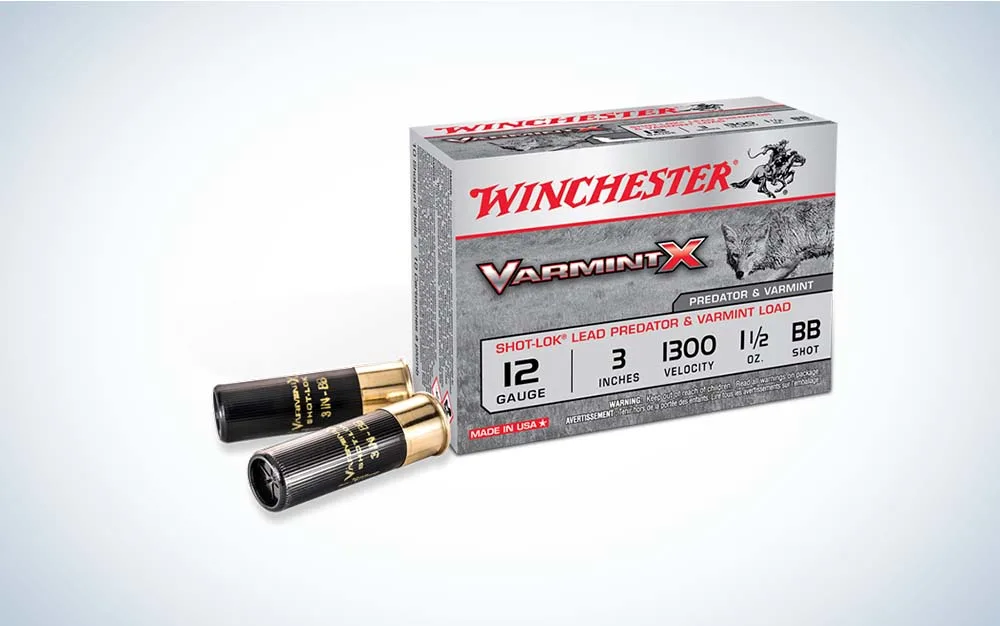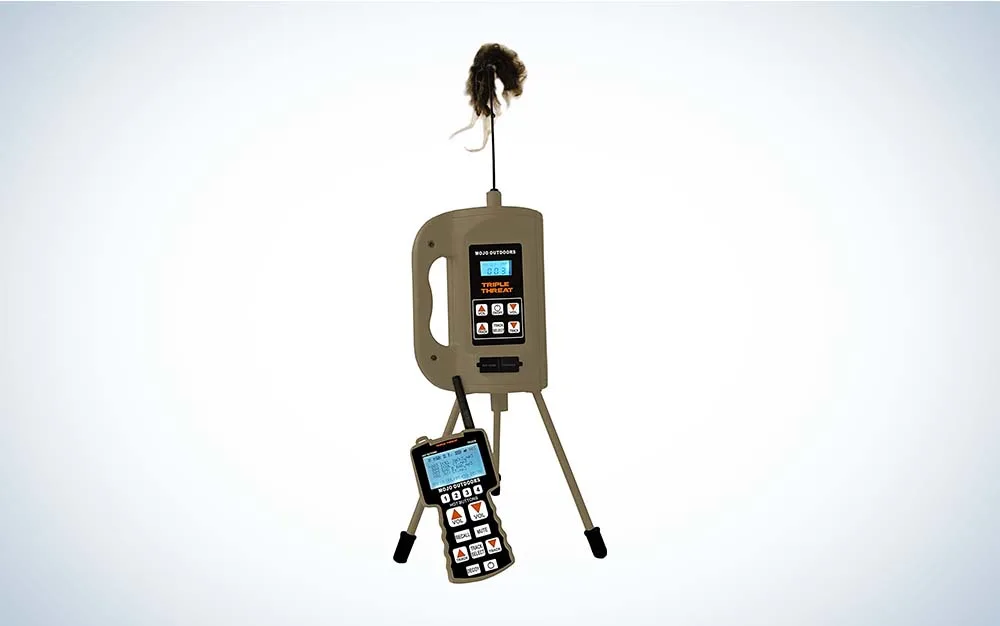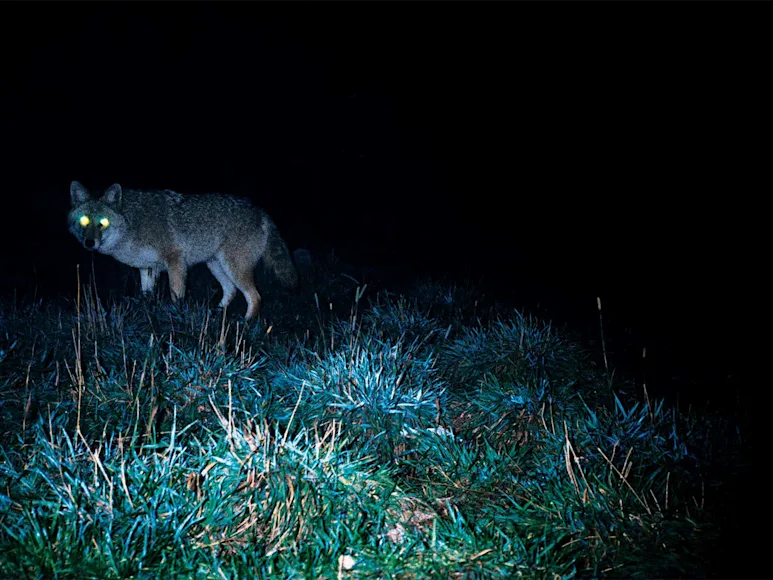It was late afternoon in February, and the farmer gave me the usual post-deer-season response when I asked if I could hunt coyotes on his land. “Go ahead,” he said. He even pulled on a weathered Carhartt coat, stepped onto his porch stoop, and motioned toward a creek drainage separating his cornfield from the neighbor’s hayfield. “Right down in there is where we usually see them cross.” Then he added, “They eat my chickens, so kill ’em all.”
I said thanks and reminded him that I’d be hunting at night and not to be alarmed if he heard a shotgun blast or two in the dark. Then I drove home for supper—and to charge the batteries for the spotlight and e-caller.
By the time my buddy Tim and I got back to the farm, it was pitch-black. We sneaked along the creek drainage with the wind in our faces and set up within a couple hundred yards of the crossing that the farmer had shown me. It was a perfect crosswind set, with the road covering our downwind side.
Tim placed his caller 20 yards into the cornfield in front of us, and we stood just a few feet apart. Hunting at night, we’ve learned that setting up with our backs to cover doesn’t hurt, but you don’t have to hide. What you do need to be is close together, so that no one accidentally casts a shadow in front of the spotlight.
My Q-beam, fitted with a red lens filter, was connected to a lawn-mower battery at my feet. I was running the spotlight on this set, and Tim was the primary shooter. We’d swap on the next setup. Tim worked the e-caller remote and started with a few howls, and then melted them into the sounds of a baby cottontail rabbit wailing for its life. I started scanning the cornfield in front of us with slow, smooth sweeps of the red beam, looking for eyes.
The Best Setup for Hunting Coyotes At Night With a Shotgun
Calling up a predator is fun at any time of day, but I get an extra charge from doing it at night. A predator’s eyes glow in a spotlight, and a red-filtered beam makes them look positively wicked. You can see those eyes from a couple hundred yards away with a good light, and you can keep tabs on them as the critter nears the call. Good night hunters learn to catch the animal’s eyes with the bottom edge of the beam—called the halo—and track them with that until they’re in range. Only hit the critter with the full beam when it’s time to shoot. Too much light too soon usually spooks them.
Predators lose some of their usual caution at night, and response rates to calls go up as a result. In the East, if you call in one predator for every 10 daylight setups, you’re doing well. At night, we get a response every three to five sets on average. I’ve been on after-dark hunts in Texas where we called up a dozen different critters in just a few hours.
Where I hunt in Kentucky, we’re limited to shotguns, which isn’t an altogether bad idea in populous areas. By the time a predator is within the 40-yard killing distance, it’s easy to tell if you’re looking at a coyote or something off-limits. With a little experience, you can tell one critter from another at a distance by the spacing between their eyes and by their gait as they come to the call. Coyotes lope in, foxes bounce, and bobcats slink.
For calling, I prefer distress sounds played without interruption. I start my sequences off at low volume and ramp it up a bit as the hunt progresses. Tim usually mixes bursts of distress sounds with silence, punctuated by frequent howls, especially if we’re hunting in February. Late winter is mating season for coyotes, and they’ll respond to howling. I can’t tell whether one calling strategy is more effective than another, so we switch it up. Most responses occur within the first few minutes, but we always give it a full half-hour because we’ve spotted eyes as we were packing to leave too.
Read Next: The 10 Best Coyote Cartridges
Work In a Team When Hunting Coyotes at Night
We heard the coyote before we saw him, which doesn’t happen often. The big male crashed through the brush in the creek drainage, just a few feet from Tim, on the upwind side, and was just about gnawing on the e‑caller when I finally got the light on him. The action was so fast and close that I flooded the dog with the full beam before thinking twice, and the coyote spooked and bolted.
I figured Tim, who was fresh off duck season, would be unfazed by a moving target, and so I just held the light steady. The coyote crumpled at 30 yards from a 3 1⁄2-inch dose of Hevi-Shot Dead Coyote
. I dropped the Q‑beam, shouldered my own 12-gauge, and activated the pressure switch to the gun light mounted on my barrel. A twitch of the coyote’s tail was all it took for me to fire a blast of my own, just for good measure.
“Pretty sure he was dead already,” Tim said.
“I didn’t bring this ammo just to carry it,” I said. He gave me the e-caller remote, and I handed him the Q-beam. “Your turn to scan,” I said, sliding in another shotgun shell.
We were only a few minutes into our first setup, and the night was young. I was betting on another pair of eager eyes.
The Best Gear For Nighttime Coyote Hunting
Nighttime predator hunting requires special equipment, and I’ve tried a bunch of it. Here are two items—one new and one tried-and-true—that I have used and recommend.
Winchester VarmintX Shotshells • $18 per 10

Winchester’s VarmintX shells are tough to find online, but they’re well-worth seeking out.
My favorite predator-specific load is Winchester’s VarmintX, which uses Shot-Lok buffering material (same as Long Beard XR) in conjunction with 1 1⁄2 ounces of lead BBs. It patterns lights-out through my turkey tube, which can’t always be said for large predator pellets.
Mojo Triple Threat Predator Call • $240
Mojo Triple Threat Predator E-Caller

Mojo’s Triple Threat Predator E-Caller
just like a dying rodent—which is exactly what you want. It comes programmed with 50 sounds, but you can play others from an SD card. The controls glow in the dark, and the remote’s range is rated to 400 yards. The Critter motion decoy on top won’t do much for you at night, but it looks killer during the day.
This article originally appeared in Vol. 125, No. 1 of Field & Stream.






